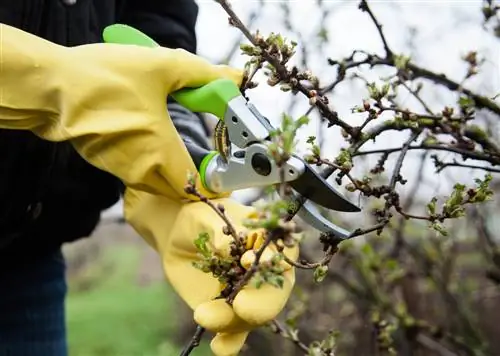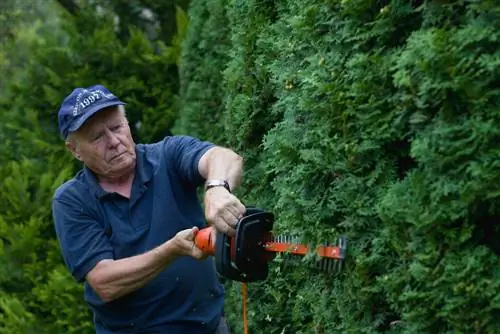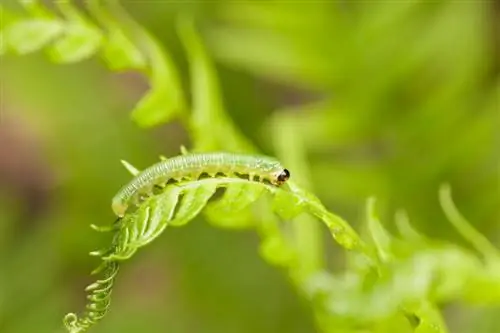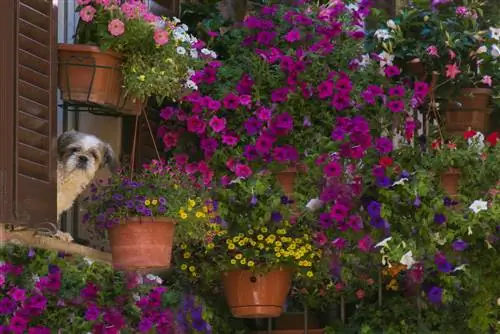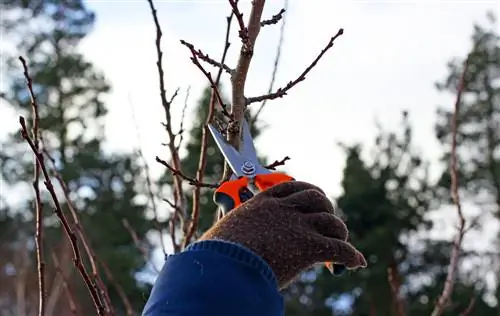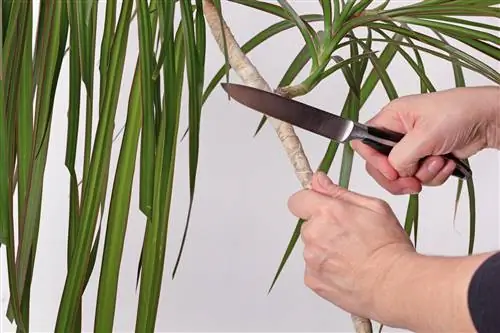- Author admin [email protected].
- Public 2023-12-16 16:46.
- Last modified 2025-06-01 06:02.
It pays to trim your shrubs every now and then. The correct cut promotes flower splendor, growth habit and vitality. The timing is just as important as the cut. This tutorial summarizes everything you need to know about the perfect pruning care of your garden shrubs. Read here when and how to skilfully prune flowering, evergreen and climbing shrubs.
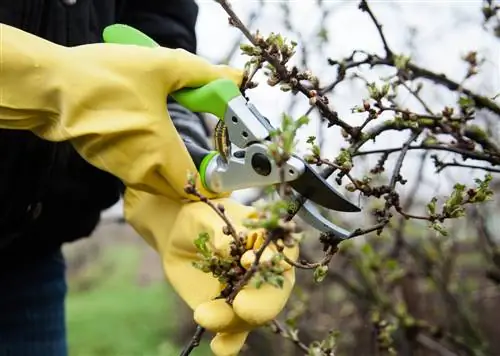
When should you cut bushes?
Spring-flowering shrubs should be pruned after flowering. The following applies to spring bloomers on short-lived shoots: the younger the shoots, the more lush the flowers. Spring bloomers on old wood, however, are rarely cut. Summer-flowering shrubs should be pruned in late winter, roses twice a year.
Pruning spring-flowering shrubs after flowering
When spring-flowering shrubs open their buds, the cold season is finally over. The most beautiful species and varieties delight with their long-lasting flowering period, decorative foliage coloring and/or attractive fruit decorations in autumn.
Spring bloomers have already laid out the flower buds for the color festivallast year, such as the wonderful forsythia, picturesque lilacs and spectacular bridal spars. In order not to destroy the valuable flowering plants, cut these bushes onlyafter the flowering periodThe cutting method and extent of cutting depend on whether the flowers develop on short-lived, one- to two-year-old or long-lasting shoots. The following table lists popular spring bloomers and differentiates between short-lived and perennial flowering plants. You can read more detailed explanations of expert cutting below the table.
| Flowers on short-lived shoots | Flowers on perennial wood |
|---|---|
| Spring spar, bridal spar (Spiraea thunbergii and others) | Rock pear (Amelanchier lamarckii) |
| Broom broom, dyer's broom (Cytisus species) | Alpine clematis, mountain clematis (Clematis species) |
| Ornamental raspberries (Rubus species) | Flower dogwood (Cornus florida, Cornus cousa) |
| Forsythia, golden bells (Forsythia) | Lilac (Syringa vulgaris) |
| May flower bush (Deutzia) | Pipe bush, farmer's jasmine (Philadelphus coronarius) |
| Weigelia (Weigelia) | Barberry, sour thorn (Berberis) |
| Tree peony (Paeonia suffruticosa) | Ornamental cherries (Prunus species) |
| Honeysuckle (Lonicera) | Azalea (Rhododendron species) |
Some popular spring bloomers should not be cut or cut very little. These include witch hazel (Hamamelis), magnolia (Magnolia), spindle bush (Euonymus alatus) and cornelian cherry (Cornus mas). That doesn't mean that using scissors and saws is completely taboo. You can easily prune awkwardly positioned branches or dead wood.
Spring bloomers on short-lived shoots - this is how to prune correctly
The rule of thumb for spring-flowering shrubs in this category is: the younger the shoots, the more lush the flowers. As the illustration below shows,thorough thinning makes a significant contribution to promoting young flowering wood. Thin out ground shoots that have already bloomed twice at the base. There should be no shoots older than 3 years if you want opulent spring blossoms. How to cut correctly:
- Cut back wilted flowers to the next pair of leaves or a lower branch
- Thin out ground shoots at the base that have already produced flowers two or three times
- Do not cut this year's young shoots (recognizable by the light, soft wood)
- Overhanging, heavily branched shoot tips lead to a deeper, outward-facing side shoot
The perfect pruning of shrubs in this category is aimed atcontinuous rejuvenation If you remove older ground shoots, there should already be a corresponding number of young shoots. Young wood can usually be recognized by its unbranched growth, light-colored bark and noticeably softer structure. At the time of cutting, the shoots are still growing and are not trimmed.
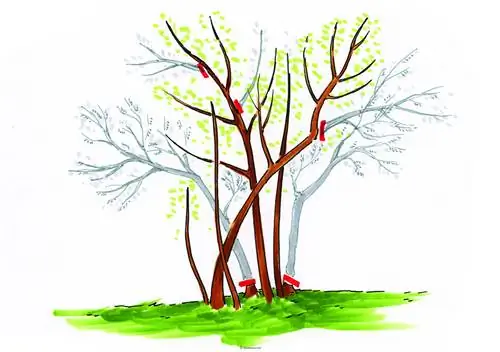
If spring bloomers bloom most beautifully on short-lived, one- to two-year-old wood, cut off at least a quarter of the older shoots at ground level after flowering. Do not leave any ground shoots that are older than 3 years old.
Prune spring bloomers on old wood - this is how you do it right
When shrubs plant their spring flowers onperennial wood, the scissors are only usedrarely. Serviceberry, alpine clematis, lilac and barberry bloom tirelessly, even if you are not ready with the scissors every year. How to prune shrubs that let their spring flowers shine on perennial shoots:
- After the flowering period: clean out withered flowers (on azaleas, pinch them out with your fingers)
- Shrubs with autumnal fruitsdon't clean out
- Shoots that hang out of the bush shape or are too long can be slimmed down with a derivation cut
- Dead wood, weak, frozen and inward-facing branchesThin out in February
Shrubs in this category also benefit fromcontinuous rejuvenation - albeit in a reduced form. Each late winter, select the oldest or weakest ground shoot. Cut the branch at the base to make room for a replacement young scaffold shoot.

When spring bloomers bear their buds on perennial wood, annual pruning care is limited to cleaning out the bushes after flowering. This applies to all flower beauties that forego spectacular fruit decorations in autumn or produce poisonous berries, like this lilac bush.
Background
Derive long, heavily branched shoots instead of shortening them
One of the fundamental basic techniques for pruning shrubs is derivation pruning. If you master this cutting technique, you will never have to worry about unsightly gaps after cutting back. To trim a shoot that is too long or has a lot of branches at the tip, look for a side shoot positioned further down. This side shoot should be strong and vital and directed outwards. Use the scissors where old and young wood forks. The previously subordinate side shoot now takes over the leading position without the interface being recognizable as a gap. The image below shows how to do it correctly.

The perfect derivation cut takes place where old, worn-out and young wood fork on the shoot.
Cut summer-flowering shrubs in February
Summer-flowering shrubs shine in all their splendor onthis year's shoots, which spring from a stable, permanent framework. This property allows for a never-ending flowering period and makes pruning easy for the gardener. High-profile florals in this category are buddleia (Buddleja davidii), marshmallow (Hibiscus syriacus), summer spar (Spiraea japonica) and panicle hydrangea (Hydrangea paniculata) as well as viburnum hydrangea (Hydrangea arborescens). This is how you properly prune your summer-flowering ornamental trees:
- The best time is in late winter (January to early March)
- First remove all dead, weak, criss-crossing and inwardly growing branches
- Cut back dead shoots from the previous year by half or a third
- For optimal flower abundance, shorten all last year's shoots to just a few centimeters above the base of the main branch
In the first few years you build up a species-specific framework consisting of 3 to 7 (buddleia and hibiscus) or 10 to 15 (spear bushes) ground shoots. To keep this framework young and vital, thin out some of the oldest ground shoots every year and train young shoots to form a new framework.
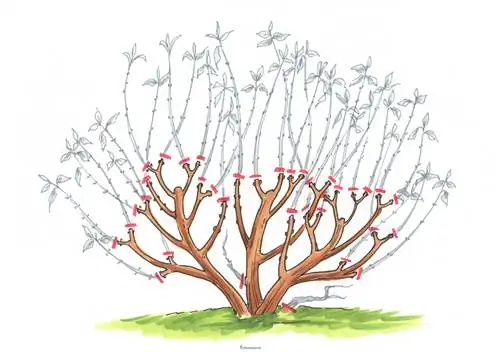
Summer-flowering shrubs, like this buddleia, are cut back heavily in February. Prune dead shoots from the previous year to 5 centimeters above the base of the scaffold shoot. For a more moderate cut, cut the bush by a third or half.
Special case of roses - cut bed and shrub roses twice a year
The queen of flowers insists on special treatment when it comes to pruning care. As a result, many private rose gardeners are plagued by doubts and prune the noble flowering bushes too timidly. The result is long-legged, bare-bottomed rose bushes with few flowers at the tips of the branches. Your bed and shrub roses can do this better if you pave the way for them with acourageous cut in spring. This is how it works:
- Best time for themain rose pruningis at the time offorsythia blossom (beginning of March to beginning of April)
- Cut off old and heavily woody ground shoots at the base
- Leave 3 or 4 of the most vital shoots on weakly growing rose bushes
- Thimout strong-growing rose bushes down to 5 or 6 ground shoots worth preserving
- Cut back any remaining ground shoots to 20 cm or 4 eyes
Your rose bushes will receive arose care cut after thefirst bloomRose care cut Depending on the type of rose, cut in June/July and again in September/October withered flower heads fall over the next he althy leaf. Primarily replanting bed and shrub roses rely on repeated care pruning. Once rose hips have formed, your rose bushes will rigorously refuse any more flowers and will only allow themselves to be persuaded to produce weak subsequent blooms in the fall.

The forsythia blossom signals the start of the main pruning of rose bushes. Thin out dead wood and weak shoots. 3 to 4 ground shoots remain on weakly growing roses and 5 to 6 on strong growing roses. Shorten these heavily down to 4 buds
Pruning evergreen deciduous shrubs rarely
Evergreen deciduous trees wear their leaves in every season. High priests of creative garden design advocate choosing at least a fifth of all shrubs from evergreen species so that the winter garden does not end up completely empty. If the basic green chord in the appearance is not enough, choose rhododendron, whose magnificent flowers sparkle like precious stones above the evergreen foliage in spring. When yellow flowers glow in the shade in April and May, the evergreen Mahonia is achieving its floral masterpiece. Holly leaves their inconspicuous spring blossoms followed by bright red fruit decorations in winter.
Evergreen deciduous shrubs are very popular with gardening beginners because they are easy to cut. This also applies to classic hedge shrubs that present themselves as evergreen soloists, such as boxwood, viburnum and cherry laurel. Note these pruning measures in the care program for your evergreen deciduous shrubs:
- Rule of thumb: rarely cut evergreen shrubs, only when necessary
- Best time for clearing out dead wood and cutting frozen branches: February to early March
- Best time for moderate pruning of individual shoots: end of June (St. John's Day) to mid/end of July
- Shoots that are too long, out of shape or bald can be attributed to a young side shoot
- Pick out wilted flowers on rhododendrons by hand
When cutting back excessively long branches on evergreen shrubs, please leave2 centimeter long cones. The cones make a valuable contribution to new growth. Stylish rhododendrons in particular benefit from this cutting technique. But a cherry laurel as a solitary shrub also sprouts diligently if you cut it into cones. The illustration below uses the example of an evergreen laurel snowball to illustrate what is important when it comes to pruning care.

In February or June, divert branches that are too long onto a young side shoot. A short tenon optimizes new growth. In late winter, also remove dead wood to short cones.
Tip
A separate tutorial is dedicated to hedge trimming. When flowering, deciduous or evergreen shrubs gather to form a green wall, special pruning is required. You cut a formal hedge more often than a free-growing natural hedge. You can read here what you should pay attention to when cutting hedges as privacy screens, bed borders and fencing.
Complete a rejuvenation cut in winter - this is how you can turn back time
If deciduous bushes are not cut or thinned out for many years, they will age. The once magnificent flowering and ornamental trees degenerate into an unsightly thicket of many old and a few young shoots. Often there is no way for scissors and saws to clear out individual branches. Instead of clearing out old bushes, turn the floral wheel of time with a rejuvenating cut and try to rebuild. The chances of success depend on the plant species' basic tolerance to cutting. The following overview summarizes the general framework for expert cutting:
- The best time is during the leafless period between November and February
- In the first step, thin out as large a proportion of dead wood as possible
- Prune shrubs that tolerate pruning to knee height or ground level
- Rejuvenate shrubs that are sensitive to cutting in stages: rejuvenate a quarter of the shoots every winter
Various types of trees are not suitable for rejuvenation pruning. These include magnolias, farmer's hydrangeas, flowering dogwoods, witch hazel and other shrubs that naturally do not tolerate pruning well. Before you radically trim bushes or plant them on a tree, please ask your local tree nursery.
Background
Winter rejuvenation pruning respects summer grace period
For many decades, the pitiful peeping of birds from bushes and hedges was drowned out by the summer noise of hedge trimmers. The weeks before and after St. John's Day at the end of June were considered the traditional date for pruning. The increasing awareness of the local wildlife in general and endangered breeding birds in particular led to a rigorous rethinking. This is expressed in the Federal Nature Conservation Act. Paragraph 39 stipulates a ban on hedge and tree trimming between January 1st. March and September 30th. Light maintenance cuts are permitted if it is guaranteed that there are no nesting birds in the wood. Radical pruning measures, such as thinning out and placing on the stick, may be carried out from October 1st to February 28th, provided there are no feathered or fur-bearing winter guests in the hedge, treetop or bush.
How to cut conifer bushes correctly
Conifers thrive as evergreen shrubs with a dense coat of needles. In contrast to evergreen deciduous shrubs, needled shrubs do not respond well to pruning. The reason for the stubborn growth behavior is the lack of sleeping eyes. Beneath their green needles, conifers do not have dormant buds from which they could sprout after vigorous pruning. Thuja, cypress or juniper bushes naturally develop a harmonious shape and can safely do without pruning. If cheeky shoots disrupt the well-groomed appearance or if dead wood is spreading inside the bush, fix the problem like this:
- Rule of thumb for pruning conifers: always cut in the green shoot area
- The best time is between January and the beginning of March on a frost-free day
- Excessively long shoots in the needled area divert to short side shoots inside the bush
- Only thin out dead wood if there is no bare spot or brown gap
Coniferous bushes that are too large cannot be radically reduced in size by pruning. In this case, you should replace the conifers with a younger species that is naturally short in stature. A rejuvenation cut on conifers inevitably results in the total loss of the shrubs.
Exception: Yew impresses with its good-natured tolerance to pruning
Yew trees (Taxus) are a notable exception when it comes to pruning tolerance. All species are adaptable and tolerate cutting into old wood if the measure is unavoidable. The densely needled conifer is popular among home gardeners for evergreen borders or year-round privacy hedges. Without regular pruning, the yew develops into a multi-stemmed shrub that reaches a majestic 10 to 15 meters in height when it matures. In small gardens, slender columnar yews are useful as decorative solitary shrubs or elegant hedges. However, the yew is highly poisonous and not suitable for the family garden.
Regardless of good pruning tolerance, annual maintenance pruning of yews is not necessary. If individual, overly long shoots protrude from the bushes, a drainage cut solves the aesthetic problem. Yew bushes that have become too large can be rejuvenated and reduced in stages over several years. The best time to prune is in February. Cut back a quarter of the longest branches to short cones. Strong branches lead you to a young, short side shoot.
Excursus
The right tools make cutting bushes a successful project
Some of the most beautiful shrubs, like the wonderful lilac, belie their hard, unruly wood with their furious blossoms. But evergreen shrubs such as boxwood and deciduous hornbeam are also classified as hardwoods. For the perfect cut,high-quality scissors and saws in brand quality are just as important as the cut itself. This also applies to softwood bushes, whose shoots are crushed by inferior blades and offer pathogens an open flank. A basic set of equipment is recommended: one-handed scissors (up to 1.5 cm thick), one-handed pruning shears with ratchet gear (up to 3 cm thick), two-handed pruning shears (up to 4 cm thick) and a folding saw or hacksaw for really thick branches.
Frequently asked questions
I would like to create a natural garden. Which shrubs are best suited as bird feeders?
Native wild trees are a paradise for birds and insects. The shrubs decorate the garden with their magnificent abundance of flowers, dense foliage and bright berries. Hawthorn (Crataegus prunifolia), wild pear (Pyrus communis), black elderberry (Sambucus nigra), cornelian cherry (Cornus mas), blackthorn (Prunus spinosa) and serviceberry (Amelanchier lamarckii) are recommended. We would like to recommend wild roses, such as the sand rose (Rosa carolina) and the dog rose (Rosa canina). The bushes bloom tirelessly from summer until the first frost and provide local bird species with a valuable source of food in the form of nutritious rose hips.
The harsh winter this year left many of my shrubs in the garden with frost damage. What can I do?
Wait until the beginning/mid of May. After the Ice Saints you can clearly see the extent of the frost damage. Cut affected bushes back to he althy wood. You can easily determine the transition from frozen to vital wood. Scrape off some of the bark with your fingernail or knife. Frozen wood can be identified as brown, dark tissue. You can recognize he althy wood by its fresh green color and juicy consistency.
I would like to plant the beautiful flower balls of hydrangeas in my garden. Which hydrangea bushes remain decorative and vital even without annual pruning?
Farmer hydrangeas beautify the garden with nostalgic flowers without you having to trim the bushes. On the contrary, Hydrangea macrophylla and the varieties resulting from it are extremely sensitive to cutting. They lay the flower buds for the coming year the previous year, so cutting them back in late winter is not advisable. Pruning care is limited to cleaning out wilted flower heads to make room for the buds underneath. Continuous rejuvenation is recommended. From the fourth year onwards, the oldest ground shoots should be removed in exchange for young shoots.
Are ground cover shrubs to be cut in the same way as upright shrubs?
The most popular shrubs with creeping shoots are ivy (Hedera hexlix), fat man (Pachysandra terminalis) and the indestructible loquat (Cotoneaster dammeri). It is up to your individual assessment whether and to what extent you cut the ground cover. For strong branching and dense foliage, it is definitely beneficial to shorten tendrils that are too long by a third or half in late winter. This ensures that your ground cover shrubs cover the soil with opaque vegetation and reliably suppress annoying weeds.
The 3 most common cutting mistakes
If shrubs keep their flowers under wraps, conifers are spoiled with brown gaps or ornamental trees age prematurely in their prime, they have fallen victim to a pruning error. So that you don't have any mishaps when caring for garden shrubs, the following table lists the 3 most common cutting errors that cause damage and gives tips for prevention.
| Cutting errors | malicious image | Prevention |
|---|---|---|
| wrong cutting time | Failure of flowers | Spring bloomers after flowering, cut summer bloomers in February |
| Conifer cut into the old wood | brown gaps that no longer close | Always cut needle bushes in the needled shoot area |
| never photographed | shrubs that are balding from the inside and below, prematurely aging | remove dead wood from all bushes regularly |

Tip
When you transplant shrubs in the garden, a large part of the root volume is lost. Most species and varieties cope better with the loss if you cut back all shoots by at least a third to a maximum of two thirds. In this case, bushes that are already sensitive to cutting should not be bothered with scissors. These include farmer's hydrangeas (Hydrangea macrophylla), rhododendrons and azaleas (Rhododendron species).

